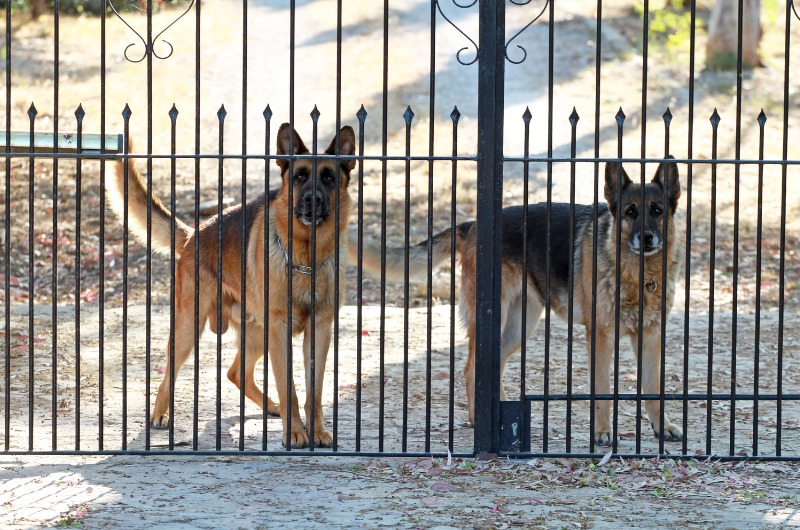Approximately 40,000 years ago, humans domesticated wild wolves for the first time. From that point onwards, canines became our companions, our hunting partners, and our protectors. The fact that dogs were capable of offering early hunter-gatherers considerable protection against other animals was probably the main reason we decided to selectively breed these animals over such a long period, leaving us with breeds that are even bigger than their wolf ancestors. Today, mastiffs, rottweilers, and Pitbulls are a few of the most notable dogs that can provide security to residences in Chicago. Not only can dogs physically attack threats, but they can also bark – providing a sort of “biological alarm bell” that both frightens away trespassers and notifies homeowners.
You might think that phrases like “guard dog,” “watchdog,” and “attack dog” are interchangeable. However, these three types of dogs exhibit different behaviors and serve completely different functions. Understanding the differences may help you to avoid being attacked.
The Definition of a Guard Dog
A guard dog is probably the most common type of guardian canine used by property owners in Illinois. These animals are often quite intimidating in appearance, and they typically bark in a loud, threatening manner. Guard dogs are also well-rounded beasts, having good enough hearing and eyesight to detect danger from long distances. But as threatening as a guard dog may be, their primary function is not to inflict physical injuries on suspected trespassers. Instead, their first priority is to hold their ground and simply scare the trespasser away by barking, growling, and baring their teeth. Usually, this is more than enough to make someone think twice about setting foot on the property.
This is a good thing because dogs cannot easily distinguish between people who are meant to be on the property and people who are trespassing. Dogs are famous for barking and harassing mail carriers – even though all humans understand that these people are just trying to do their jobs. A guard dog will only become relaxed when it becomes familiar with the smell and sight of a new person. This means that even if someone invites a friend over, the guard dog will not necessarily pick up on your amicable body language and cease its aggressive behavior. Because of their ability to restrain themselves, guard dogs often make good family pets that are loving and friendly.
That being said, guard dogs are capable of becoming physically violent if necessary. If their scare tactics are having no effect and the suspected tresspasser continues to move into the property, a guard dog may burst forward, latching onto the victim with its teeth and causing serious damage. In the end, the ability of a guard dog to distinguish between friend and foe comes down to their training. Poorly-trained guard dogs can pose a real threat to innocent people – even if their first instinct is to scare rather than attack.
There are a number of dog breeds that are well-suited to this role, including:
- Akita
- Appenzeller Sennenhund
- Australian Shepherd
- Bulldog
- Belgian sheepdog
- Catahoula Leopard Dog
- Caucasian Shepherd Dog
- Collie
- Chesapeake Bay Retrievers
- Doberman Pinscher
- Estrela Mountain Dogs
- Giant Schnauzer
- Puli
- Romanian Mioritic Shepherd Dog
The Definition of a Watchdog

The clue is right in the name: A watchdog’s primary role is to detect possible threats and notify its owner with a sharp, loud bark when they notice something out of the ordinary. Remember, dogs have much more acute senses than humans. They can hear and smell things that we could not possibly detect with our own ears and noses. Often, watchdogs perk their heads up when they hear distant footsteps at your front gate or back porch. Breeds with the best hearing include very small dogs that you wouldn’t normally associate with security, such as chihuahuas and French bulldogs.
But hearing is not quite enough to make for a good watchdog. In order for these animals to truly shine, they need to be capable of barking very loudly. Their role is not only to detect threats but also to notify their owners. After all, many watchdogs are too small to accomplish much in a physical sense. However, their owners may be able to react quickly after a bark. For example, they might get help from another family member or call 9-1-1 as soon as possible after hearing a bark from their watchdog.
Some of the best watchdog breeds include:
- Chihuahuas
- Terriers
- Poodles
- Shi Tzus
- Miniature pinscher
- Lhasa Apso
- Cocker spaniel
- Labrador retriever
The Definition of an Attack Dog
Again, the name here is a bit of a giveaway. Attack dogs fill one role: Physical aggression. Unlike guard dogs, their aggressive behavior is not just for show. In fact, an attack dog is usually trained to skip the aggressive posturing altogether and go straight for the kill. This means that when an attack dog spots a potential trespasser, it will often sprint straight toward the target and immediately bite them. That being said, attack dogs can also be incredibly well-trained – remaining passive until their owner gives the command to engage the target. The best attack dogs are used by law enforcement organizations and the military, and these animals are exceedingly loyal and obedient, with solid social skills.
On the other hand, a poorly-trained attack dog can easily cause severe injury or even death to innocent people. Many attack dogs are left unattended in yards. Some might suddenly decide to attack without warning and without the appropriate command from their owner. Some attack dogs have a history of abusive training, making them psychologically traumatized and more likely to hurt others.
The most common attack dog breeds include:
- Pitbulls
- Bullmastiffs
- Rottweilers
- German shepherds
- Belgian Malinois
- Cane Corso
- American Bulldog
- Boxer
- Rhodesian Ridgeback
- Beauceron
- Briard
- Staffordshire Terrier
- Great Pyrenees
- Neapolitan Mastiff
But Wait - What is a “Protection Dog”?
You may have heard another term being thrown around when it comes to security dogs: “Protection dog.” A protection dog is trained to be obedient to you – and only you. Guard dogs are like security guards – their role is to protect a specific area or property. On the other hand, protection dogs are like personal bodyguards. They become members of the family and exhibit incredible levels of loyalty. They are perfectly capable of playing with children and smaller pets and must have a specific temperament and personality. But when a threat arises, a protection dog reacts without a second thought – often putting their lives on the line to protect family members.
This type of animal goes through much more extensive training than a typical guard dog or watchdog. The training is so intense that only a few dogs have the necessary intelligence to complete it. Personality is also a factor, and only specific breeds are suited to this role. One of the few dogs that can fill this role is a Doberman. One of the biggest misconceptions is that guard dogs are the same as protection dogs. Although there are some similarities, the training behind these animals is completely different.
How to Stay Safe Around Watchdogs, Guard Dogs, and Attack Dogs
The number-one rule is never to assume that a particular dog is safe. The truth is that you probably cannot distinguish between an attack dog and a guard dog at a moment’s glance. Even though a specific breed might be more common for use as a guard dog, there is no guarantee that it has not been trained as an attack dog. Do not count out small dogs, either. Even though watchdogs might be trained to simply bark to raise the alarm, they probably have a decent set of teeth that can do some damage if you’re not careful.
If you feel like a dog is threatening you, the safest course of action is to leave the property. A well-trained guard dog will not follow you off the premises. If you are dealing with an attack dog and there is nowhere to run, you can try turning your body to the side and remaining still while avoiding eye contact. If possible, climb onto an elevated surface, such as a car or a low roof.
Where Can I Find a Qualified Dog Bite Attorney in Chicago?
If you have been searching for a qualified, experienced dog bite attorney in Chicago, look no further than Palermo Law Group. Whether you have been attacked by a watchdog, an attack dog, or a guard dog, the end result is always the same: You need justice and compensation. The best way to pursue positive results is to get in touch with us at your earliest convenience and book a consultation. During your consultation, we can discuss the specifics of your situation and recommend the best course of action. A settlement can help you pay for medical costs, missed wages, and the emotional distress associated with disfiguring or traumatic injuries. Book your consultation today, as the statute of limitations may become an issue if you wait too long.


